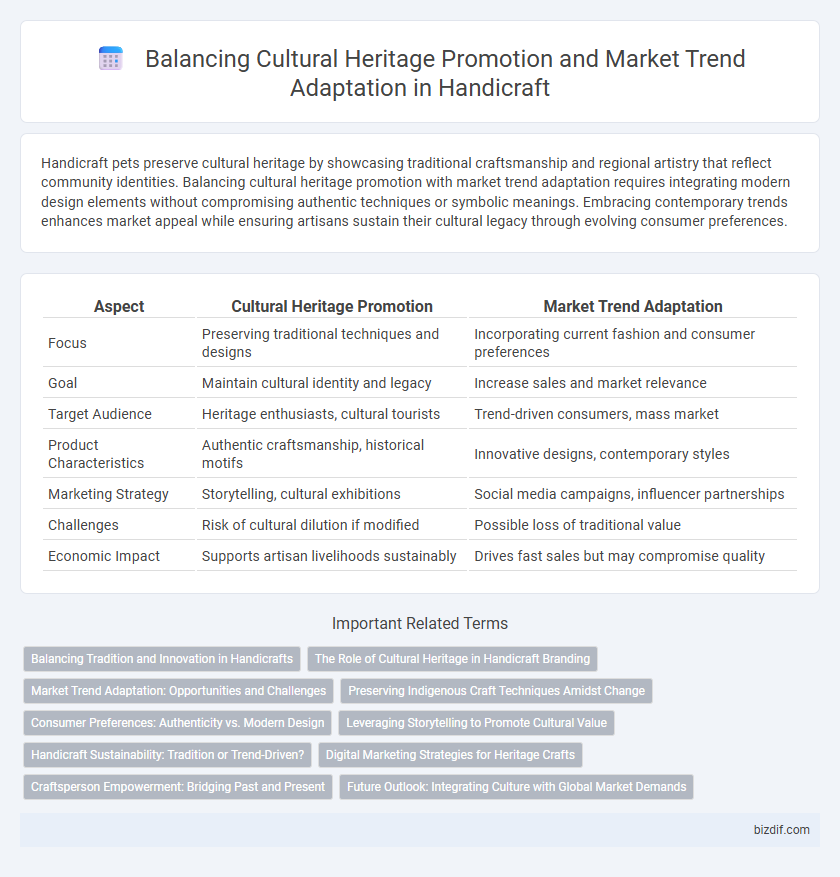Handicraft pets preserve cultural heritage by showcasing traditional craftsmanship and regional artistry that reflect community identities. Balancing cultural heritage promotion with market trend adaptation requires integrating modern design elements without compromising authentic techniques or symbolic meanings. Embracing contemporary trends enhances market appeal while ensuring artisans sustain their cultural legacy through evolving consumer preferences.
Table of Comparison
| Aspect | Cultural Heritage Promotion | Market Trend Adaptation |
|---|---|---|
| Focus | Preserving traditional techniques and designs | Incorporating current fashion and consumer preferences |
| Goal | Maintain cultural identity and legacy | Increase sales and market relevance |
| Target Audience | Heritage enthusiasts, cultural tourists | Trend-driven consumers, mass market |
| Product Characteristics | Authentic craftsmanship, historical motifs | Innovative designs, contemporary styles |
| Marketing Strategy | Storytelling, cultural exhibitions | Social media campaigns, influencer partnerships |
| Challenges | Risk of cultural dilution if modified | Possible loss of traditional value |
| Economic Impact | Supports artisan livelihoods sustainably | Drives fast sales but may compromise quality |
Balancing Tradition and Innovation in Handicrafts
Balancing tradition and innovation in handicrafts involves preserving cultural heritage while adapting to evolving market trends through the integration of modern designs and techniques. Artisans can promote cultural stories and traditional craftsmanship by incorporating contemporary aesthetics that appeal to global consumers without diluting authenticity. This approach sustains the cultural significance of handicrafts while enhancing their market viability and economic impact in the creative industry.
The Role of Cultural Heritage in Handicraft Branding
Cultural heritage plays a pivotal role in handicraft branding by embedding authentic narratives and traditional craftsmanship into product identity, which enhances market differentiation. Emphasizing indigenous techniques and motifs not only preserves cultural legacy but also appeals to niche consumers seeking unique, ethically-sourced products. Balancing heritage authenticity with evolving market trends ensures sustained relevance and competitiveness in the global handicraft industry.
Market Trend Adaptation: Opportunities and Challenges
Market trend adaptation in handicraft offers opportunities for artisans to reach broader audiences and increase sales by integrating contemporary design elements and leveraging online platforms. Challenges include maintaining authenticity and cultural significance while catering to changing consumer preferences and ensuring sustainable production methods. Balancing innovation with traditional craftsmanship is crucial for preserving cultural heritage within a competitive global market.
Preserving Indigenous Craft Techniques Amidst Change
Preserving indigenous craft techniques ensures the survival of cultural heritage by maintaining traditional methods and unique artistic expressions passed down through generations. Adapting to market trends can introduce innovation but must balance commercialization with authenticity to avoid diluting cultural significance. Sustaining handicrafts requires collaboration between artisans, cultural organizations, and consumers to protect craftsmanship while embracing evolving demands.
Consumer Preferences: Authenticity vs. Modern Design
Handicraft artisans face the challenge of balancing cultural heritage promotion with market trend adaptation, as consumer preferences diverge between valuing authenticity and seeking modern design. Traditional techniques and motifs resonate with buyers interested in cultural stories and craftsmanship, preserving intangible heritage. Conversely, incorporating contemporary aesthetics appeals to younger demographics eager for stylish, functional pieces, driving innovation within the craft industry.
Leveraging Storytelling to Promote Cultural Value
Leveraging storytelling in handicrafts enhances cultural heritage promotion by connecting artisans' traditional techniques with consumers' desire for authentic narratives, enriching the product's cultural significance. Embedding detailed stories about origin, craftsmanship, and cultural symbolism increases consumer engagement and elevates perceived value against fleeting market trends. This approach fosters sustainable demand while preserving intangible cultural assets and supporting artisanal communities globally.
Handicraft Sustainability: Tradition or Trend-Driven?
Preserving cultural heritage in handicrafts ensures the transmission of traditional skills and authentic narratives, vital for sustainable artisan communities. Market trend adaptation drives innovation and economic viability, enabling crafts to remain relevant to contemporary consumers. Balancing tradition with trend-driven strategies fosters handicraft sustainability by honoring cultural identity while embracing evolving market demands.
Digital Marketing Strategies for Heritage Crafts
Digital marketing strategies for heritage crafts drive cultural heritage promotion by leveraging storytelling and immersive visuals that highlight traditional techniques and artisan stories. Utilizing social media platforms and e-commerce channels enables artisans to reach global audiences while preserving authenticity. Data analytics and targeted campaigns help balance market trend adaptation with maintaining cultural integrity, enhancing both visibility and sales.
Craftsperson Empowerment: Bridging Past and Present
Craftsperson empowerment in handicrafts bridges cultural heritage promotion and market trend adaptation by integrating traditional skills with contemporary design innovations. This approach strengthens artisans' economic independence while preserving indigenous techniques and narratives. Empowered craftspeople become cultural ambassadors, ensuring that heritage remains vibrant and relevant in evolving global markets.
Future Outlook: Integrating Culture with Global Market Demands
Sustainable growth in handicraft hinges on balancing cultural heritage promotion with market trend adaptation by embedding traditional techniques into contemporary design to meet global demand. Leveraging digital platforms enhances visibility while preserving artisan authenticity, fostering economic empowerment and cultural continuity. Future integration strategies focus on collaborative innovation, ethical sourcing, and scalable production that respect indigenous narratives alongside commercial viability.
Cultural Heritage Promotion vs Market Trend Adaptation Infographic

 bizdif.com
bizdif.com